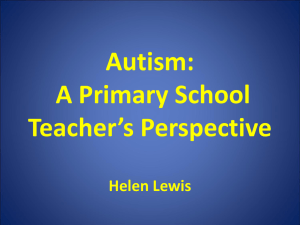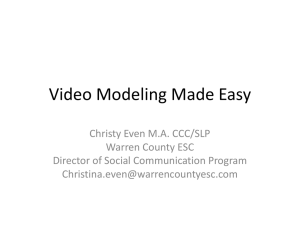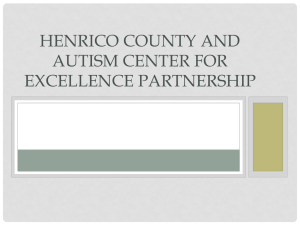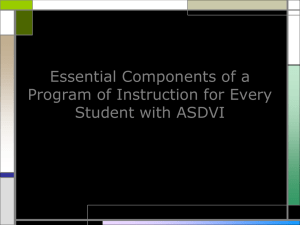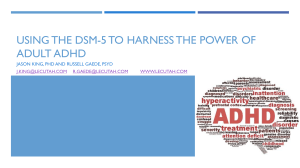Power Point Presentation - Kennedy Krieger Institute
advertisement
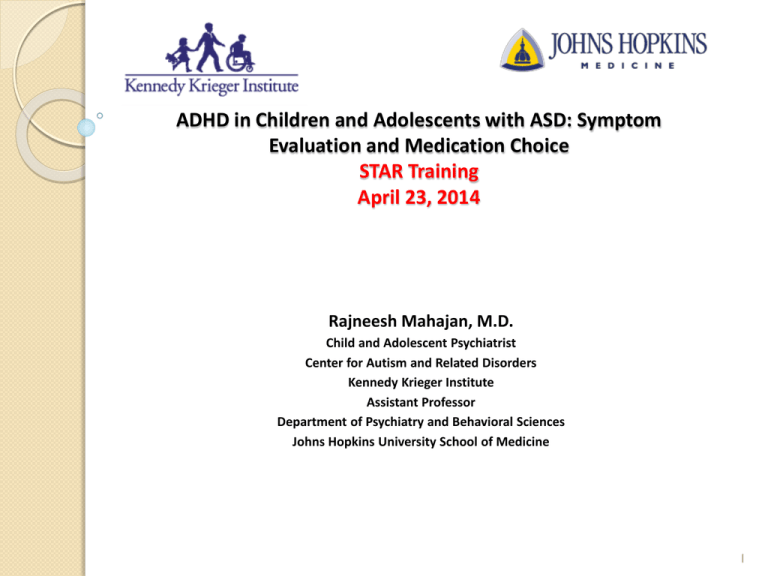
ADHD in Children and Adolescents with ASD: Symptom Evaluation and Medication Choice STAR Training April 23, 2014 Rajneesh Mahajan, M.D. Child and Adolescent Psychiatrist Center for Autism and Related Disorders Kennedy Krieger Institute Assistant Professor Department of Psychiatry and Behavioral Sciences Johns Hopkins University School of Medicine 1 Aims To discuss the comorbidity of ADHD symptoms in context of ASD. To discuss the stepwise evaluation of ADHD symptoms in ASD. To discuss treatment options for children who have ADHD symptoms in context of ASD. 2 Disclaimers I do not have any conflicts of interest. This is a general discussion for educational purposes – it is not meant to be any specific medical advice or advocacy for use of psychotropic medications. Every clinical situation is unique and specifics of treatment should be discussed with the treating provider. The practice pathways mentioned in the presentation were developed in collaboration with colleagues (pediatricians, neurologists and psychologists and child psychiatrists) at other medical centers in the US and Canada, under the auspices of Autism Speaks-Autism Treatment Network. ASD- Autism Spectrum Disorder ADHD – Attention Deficit Hyperactivity Disorder 3 Outline of the presentation Background information –comorbidity in ASD ADHD in context of ASD Symptom evaluation Medications commonly prescribed for ADHD symptoms Medication Choice for ADHD symptoms 4 Comorbidity in Children with ASD Comorbidity (co-occurence of ≥ 1 identifiable disorder in addition to ASD) is common in ASD. Simonoff et al, 2008 (population based study) – 70% had a comorbid disorder. Comorbidity depends on various factors – Age Communication abilities (expressive/receptive) Cognitive factors (Intellectual abilities) Co-ocurring medical/neurological disorders/sensory difficulties. Other vulnerabilities (such as family history) Psychosocial stressors (parental stress) Setting/context (school/home/others) Demands placed (social, educational) Children with ASD may not manifest full spectrum of symptoms of the co-ocurring disorder. Multiple comorbid disorders can co-occur, so diagnosing could be challenging Disruptive behaviors (primarily, ADHD and oppositional defiant disorder) and anxiety disorders are the most common disorders in most studies. 5 Comorbid Disorders and Challenging Behaviors are Targets for Psychopharmacological Treatments in ASD Insomnia Aggression and Selfinjurious behaviors Agitation Irritability Mood Disorders (Depressive, Bipolar, Dysregulation) Core ASD Features OCD Tic disorders Disruptive Behaviors (ADHD, ODD) Social Withdrawal Anxiety Hyperarousal 6 ASD and ADHD in DSM-5 ASD Delays in social communication ADHD Restricted and repetitive behaviors Symptoms may manifest when limited abilities are unable to keep up social demands Inattention Hyperactivityimpulsivity Symptoms must be present before 12 years 7 ADHD and ASD are both neurodevelopmental disorders that can co-occur (DSM-5) 8 Atypical developmental trajectories in ASD and ADHD Brain trajectory in ASD Attention-deficit hyperactivity disorder is characterized by a delay in cortical maturation Courchesne, 2011 Shaw, et al, 2007 9 ADHD symptoms in ASD DSM-IV did not allow concurrent diagnosis of ADHD and ASD, but DSM-5 allows clinicians to do so. ADHD symptoms (Hyperactivity, Impulsivity and Inattention) are common in children with ASD. Rates up to 78% in various studies (reviewed by Murray, 2010) . The most common comorbidity in ASD in several studies. Average 40% -50%. There is a potentially shared genetic basis (Reiersen and Todd, 2008) and phenotypic overlap (Sinzig, Walter and Doepfner, 2009) between ADHD and ASD. – Is the condition with features of both ASD+ADHD a separate phenotype unto itself? Recognition and treatment is complicated as ADHD symptoms occur in context of multidimensional nature of disabilities (Cognitive, Communication, Comorbidities) in a brain developing on an atypical trajectory. 10 Psychiatric disorders may have shared a genetic basis – environmental and other factors may influence genetic vulnerability. The Lancet, Feb, 2013 11 Practice pathways for symptom evaluation and treatment of ADHD in ASD were needed A. Practice guidelines Best practices guidelines are available for screening and evaluation of ASD from AAP (Filipek et al, 2000) and evaluation and treatment from AACAP (Volkmar et al, 1999). Best practices guidelines are available for the treatment of ADHD in typically developing children from AAP (2011) and AACAP (2007). No such practice guidelines available for comorbid ADHD symptoms in children and adolescents with ASD. B. Prevalence/awareness: Over the past decade – tremendous increase in awareness about ASD prevalence (1 in 88 children ) as well as comorbid conditions. C. Psychiatric Comorbidities Comorbidities are common – up to 70% of children have at least one comorbid psychiatric disorder (Simonoff, et al 2008). 12 Practice pathways for symptom evaluation and treatment of ADHD in ASD were needed C. Psychotropic medications More choices on psychotropic formulary (but limited FDA approval) High rate of psychotropic medication usage in children with ASD in various studies (ATN - 27% on more than one medication – Coury et al, 2012) Psychotropic medications can be extremely beneficial in ameliorating suffering, but can have significant risks if not managed appropriately or if side-effects/adverse events are missed. E. ASD is a multidimensional disorder, clinicians may not be familiar with all aspects of ASD and comorbid conditions (or psychotropic medications) – need for simple, accessible, evidence-based guidelines. 13 14 Kennedy Krieger Institute was one of the sites involved with the Autism Speaks- Autism Treatment Network (ATN). Goal is to standardize treatments and generate practice guidelines for ASD based upon empirical evidence and to provide collaboratively conduct research in ASD treatments. Members of the ATN’s Psychopharmacology Committee, Medication Choice subcommittee, comprised of specialists in treatment of ASD who conducted a systematic literature review of the clinical trials/studies for treatments for ADHD symptoms in children and adolescents with ASD . Based upon collective clinical experience/consensus two practice pathways were created - Symptom Evaluation (SE) Pathway completed first, followed by the Medication Choice (MC) Pathway. Goal was to provide clinicians (primary care providers, neurologists, psychiatrists) and family members with guidance regarding evaluation and treatment of the ADHD symptoms in context of ASD. 15 Systematic literature review 2 questions: 1. What are the indications for the following medicines in treating ADHD symptoms in ASD/PDD? 2. What are the side effects of the following medicines in treating ADHD symptoms in ASD/PDD? Search conducted using individual medications used in treatment of ADHD symptoms: Stimulants Alpha agonists Atomoxetine Atypical antipsychotics (risperidone & aripiprazole only) Antidepressant (nortriptyline) Measures graded a) Quality (quality of study design) b) Consistency (quality of patient selection) c) Directness (external validity/real life relevance) d) Effect size (presence of statistical analysis). 16 Results Total of 1255 articles were studied. 31 articles met inclusion criteria Divided into 2 tables – one for RCTs, one for non-RCTs. Most RCTs were for atypical antipsychotics. Benefit for ADHD (primarily hyperactivity) was a secondary outcome in most of these studies. Amongst ADHD focused studies, - only 3 RCTs for methylphenidate (including one for preschoolers). Only one study of antipsychotic use had positive effect on inattention (sub-study of RUPP risperidone study) 17 Results RCT ( Total - 15 studies) Stimulants – 3 only for MPH (Posey et al, 2005; Ghuman et al, 2009; Handen et al, 2000) Atomoxetine – 1 study (Arnold et al, 2008) Alpha-2 agonist – 1 study (Handen et al, 2008) Antipsychotics a) Risperidone - 5 studies (McCracken et al, 2002; Aman et al, 2009; Troost et al, 2009; Shea et al, 2004; Nagaraj et al, 2006) b) Aripirazole - 2 studies (Owen et al, 2009; Marcus et al, 2009) Others - 3 studies a) Risperidone +Adjunctive pentoxyfilline (Akhondzadeh et al, 2010) b) Risperidone + Adjunctive topiramate (Rezaei et al, 2010) c) Tianeptine (Niederhofer et al, 2003) 18 19 Symptom Evaluation Pathway Begins with a comprehensive evaluation of a child with ADHD symptoms in the presence of ASD – both diagnoses should be confirmed. Other causes should be ruled out (medical comorbidities, cognitive, speech/language, sleep) Mental health comorbidities should be ruled out Educational interventions (environmental modification/structure/Section 504 plan or IEP) and behavioral interventions tried first. In home services Medications only used if other interventions are in place and symptoms of ADHD persist. Scales used to get information about the ADHD symptoms. Reevaluate 20 Stimulant Medications First line medications for treatment of ADHD Act on the dopaminergic and noradrenergic synapses. Improve inattention, reduce hyperactivity and impulsivity. Preparations: Methylphenidate (Ritalin, Methylin, Concerta, Metadate CD, Ritalin LA) Dexmethylphenidate (Focalin and Focalin XR) Mixed amphetamine salts (Adderall, Adderall XR) Dextroamphetamine (Dexedrine, Dexedrine XR) Lisdexamphetamine (Vyvanse) Common side-effects: Reduced appetite; stomachaches; headaches; insomnia; unmasking of tics. Need baseline EKG – if there are any predisposing developmental/genetic factors for heart vulnerability. Worsening of anxiety, irritability, lowered seizure threshold 21 Alpha-2 Agonists Act centrally in the brain. Reduce hyperactivity and impulsivity, may not reduce inattention. May lower blood pressure, so BP and HR should be monitored on a particular dose initially. Preparations: -Clonidine (Catapres; Kapvay) -Guanfacine (Tenex; Intuniv) Can be combined with stimulant medications if significant hyperactivityimpulsivity and aggression. Can be prescribed independently as first line treatment if there is predominantly hyperactivity-impulsivity. 22 Atomoxetine (Strattera) Similar to older antidepressants in structure and mechanism of action. 3-4 weeks to see its effects at the effective dose. Can be used if stimulants are not effective or if there is co-occuring anxiety. Side-effects – sedation, irritability, mood swings, reduced appetite. EKG may be needed if there are predisposing factors. 23 Risperidone and Aripiprazole Atypical antipsychotics Act on dopaminergic receptors. FDA approved for treatment of irritability in children and adolescents with ASD. Use in ADHD – if there are safety concerns due to aggression reduce impulsivity (impulsive running, jumping, etc). may help with mood regulation Have risk of side effects and adverse events Sedation, tiredness Increased appetite, weight gain, hyperglycemia, high cholesterol Extrapyramidal symptoms, tardive dyskinesia Elevated prolactin (gynecomastia in boys, menstrual irregularities) May need EKG (QTc interval) 24 25 Medication Choice Pathway Stimulants tried first - although may not be as effective in ASD as in ADHD (only 49% response rate in RUPP MPH study); higher risk of adverse effects (18% d/cd due to adverse effects in RUPP MPH study). Start with methylphenidate or amphetamine salts. Atomoxetine tried next – or first, if there is comorbid anxiety Alpha-2 agonists added if symptoms not controlled by stimulants alone; can start with alpha agonists if severe hyperactivity –impulsivity predominate. Atypical antipsychotics only used - severe aggression, impulsive behaviors leading to safety concerns elopement/running/other unsafe behaviors. 26 Putting the pathways into practice Before initiating the pathways ensure accurate ASD diagnosis . SE Pathway can be completed in one or more visits, depending upon the setting. Obtain information about ADHD symptoms in multiple settings (home, school and community) – use checklists to supplement clinical history and observation. If symptoms of ADHD are significant, try educational and behavioral interventions first. If medications are being considered, initiate the MC Pathway, starting with stimulant medications. 27 Putting the pathways into practice-2 Discussion with parents very important – a) setting goals for treatment including target symptoms , time frame in which to see benefit. b) risks and benefits c) provide realistic appraisal based upon empirical evidence-base. d) Parents should call immediately if there is worsening of behaviors or if there an adverse event. Monitor for effectiveness and safety at each visit. Refer to or consult specialists as needed at any time - for clarification of diagnosis; - if unfamiliar with a medication or it use (antipsychotics); - if current therapy is ineffective. 28 Case Illustration 4 year old boy with autism, no verbal communication Significantly disruptive behaviors - overactivity and severe impulsivity including dangerous running/eloping behaviors; aggressive behaviors when limits set. Mother single parent, overwhelmed. Pediatrician prescribed risperdone 1mg/day starting dose, increasing it to 4mg/day over the next few months, with no improvement in symptoms. Seen by another pediatrician, who doubled the dose to 8mg/day due to the behavioral challenges. Next month increased it further to 12mg/day. Took it for 6 months. Seen for a psychiatric evaluation. Dose gradually decreased to 1mg/day. Added an alpha agonist and low doses of stimulant with some benefit. Concurrently, referred to a) behavioral psychology clinic for behavioral therapy and b) for speech and language evaluation and therapy; c) mother referred to clinic SW for psychoeducation and help navigating resources. 29 30 In Conclusion ADHD symptoms may cause significant impairment in children with ASD. The practice pathways can provide guidance, but clinical judgment should be used at every step. Stimulants should be used first, before atypical antipsychotic medications. More work needs to be done to understand the co-occurrence of ADHD and ASD. More RCTs are needed to evaluate the current medications used for ADHD symptoms in ASD. 31 Thanks, for your attention! 32
